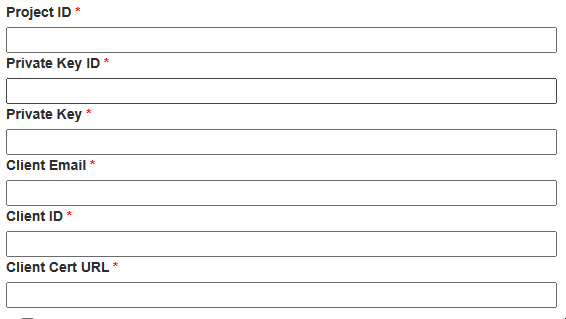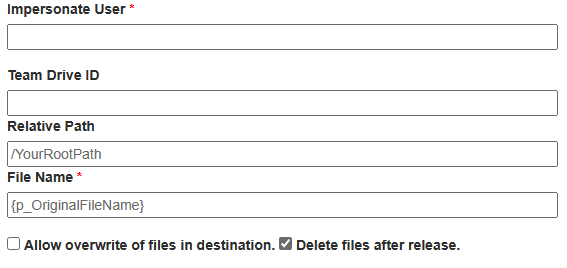Google Drive Release
Release documents to Google Drive for secure storage and sharing.

If you are looking for the ability to transfer files from GlobalCapture to Google Drive, use this node. All communications are performed over a secure channel, using standard networking ports.
Note: Square 9 does not sell or support Google Cloud services. If you are looking to release documents to a Google Drive destination, you will need to have an Google Workspace account available, a service account created, and credentials provisioned.
Configuration
The Google Drive Release node is available in the GlobalCapture nodes gallery. When downloaded, it will be made available automatically in your node toolbox. Drag and drop the node to workflow design canvas to configure the node.
First, configure the connection details. The data you will need comes from the JSON key file, which is downloaded when you create a service account and add a new key. For instructions on creating a service account, refer to the documentation found here. For authentication to work, you will need to enable domain wide delegation for the service account. Documentation for enabling delegation can be found here.

All values should be pulled from their corresponding value in the key file JSON, without the quotes wrapping the value.
Next, configure the release options:

The impersonate user field represents the Google user that will be used to write to. This should be in the form of an email address. If no Team Drive is specified, the release document will be released to this user's Google Drive location.
If the process expects to write to a Team Drive (this is a shared drive location not associated to a specific user’s account, also called a Shared Drive), provide the ID of the team drive here. The ID can be found in the URL when selecting a team drive in the browser.

The Relative Path specifies where to output the file. ShareFile does not allow the release of files to the root, so a folder path is required. Specify a path, or use notation to create a dynamic path based on data in one or more process fields. Folders, paths (or portions of paths) will be created automatically on demand.
File Name is required, and will become the output file name in the destination. Again, you can use one or more process fields to construct a valid file name. Using the notation {p_OriginalFileName} will name a file based on the original file name processed by GlobalCapture. You might also consider using {PROCESSID} to name a document based on the GlobalCapture process that sourced it.
Use the Allow overwrite option if you want duplicate files to be overwritten. If this option is unchecked and you release a duplicate file, the process WILL NOT error, but the action will be noted in the process history.
Delete files after release should be enabled for any release step that is the last release step in a workflow. This option allows GlobalCapture to clean up after itself. Unchecking this option may be useful in troubleshooting scenarios, but should always be enabled in production workflows.
File Name should not include the extension of the file. GlobalCapture will automatically append the file name with the proper extension.
Workflow
The node expects two outputs. Success and Failure. The node can write response information from Google Drive to a process field if further control routing is desired. Create a field named “Drive Status” if this is desired. Any response other than success should return helpful details in the process history.
Date | Version | Description |
|---|---|---|
01/09/2022 | 1.0 | Initial release. |
